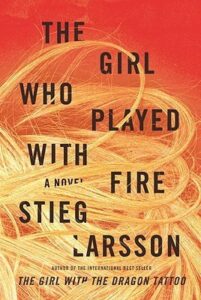The Girl Who Played with Fire by Stieg Larsson is the second book in the Millennium Trilogy. It follows hacker Lisbeth Salander as she becomes the prime suspect in a double murder case. As journalist Mikael Blomkvist investigates, dark secrets about Lisbeth's past are uncovered, leading to a thrilling conspiracy.
You are being provided with a book chapter by chapter. I will request you to read the book for me after each chapter. After reading the chapter, 1. shorten the chapter to no less than 300 words and no more than 400 words. 2. Do not change the name, address, or any important nouns in the chapter. 3. Do not translate the original language. 4. Keep the same style as the original chapter, keep it consistent throughout the chapter. Your reply must comply with all four requirements, or it’s invalid.
I will provide the chapter now.
S IX WEEKS INTO OUR MARRIAGE, Don and I shot a weepie on
location in Puerto Vallarta. Called One More Day, it was about a rich
girl, Diane, who spends the summer with her parents at their second
home, and the local boy, Frank, who falls in love with her. Naturally,
they can’t be together, because her parents don’t approve.
The first weeks of my marriage to Don had been nearly blissful. We
bought a house in Beverly Hills and had it decorated in marble and
linen. We had pool parties nearly every weekend, drinking champagne
and cocktails all afternoon and into the night.
Don made love like a king, truly. With the confidence and power of
someone in charge of a fleet of men. I melted underneath him. In the
right moment, for him, I’d have done anything he wanted.
He had flipped a switch in me. A switch that changed me from a
woman who saw making love as a tool into a woman who knew that
making love was a need. I needed him. I needed to be seen. I came
alive under his gaze. Being married to Don had shown me another
side of myself, a side I was just getting to know. A side I liked.
When we got to Puerto Vallarta, we spent a few days in town before
shooting. We took our rented boat out into the water. We dived into the
ocean. We made love in the sand.
But as we started shooting and the daily stresses of Hollywood
started fracturing our newlywed cocoon, I could tell the tide was
turning.
Don’s last movie, The Gun at Point Dume, wasn’t doing well at the
box office. It was his first time in a Western, his first crack at playing
an action hero. PhotoMoment had just published a review saying, “Don
Adler is no John Wayne.” Hollywood Digest wrote, “Adler looks like a
fool holding a gun.” I could tell it was bothering him, making him
doubt himself. Establishing himself as a masculine action hero was a
vital part of his plan. His father had mostly played the straight man in
madcap comedies, a clown. Don was out to prove he was a cowboy.
It did not help that I had just won an Audience Appreciation Award
for Best Rising Star.
On the day we shot the final good-bye, where Diane and Frank kiss
one last time on the beach, Don and I woke up in our rented bungalow,
and he told me to make him breakfast. Mind you, he did not ask me to
make him breakfast. He barked the order. Regardless, I ignored his
tone and called down to the maid.
She was a Mexican woman named Maria. When we had first
arrived, I was unsure if I should speak Spanish to the local people. And
then, without ever making a formal decision about it, I found myself
speaking slow, overenunciated English to everyone.
“Maria, will you please make Mr. Adler some breakfast?” I said into
the phone, and then I turned to Don and said, “What would you like?
Some coffee and eggs?”
Our maid back in Los Angeles, Paula, made his breakfast every
morning. She knew just how he liked it. I realized in that moment that
I’d never paid attention.
Frustrated, Don grabbed the pillow from under his head and
smashed it over his face, screaming into it.
“What has gotten into you?” I said.
“If you’re not going to be the kind of wife who is going to make me
breakfast, you can at least know how I like it.” He escaped to the
bathroom.
I was bothered but not entirely surprised. I had quickly learned that
Don was only kind when he was happy, and he was only happy when
he was winning. I had met him on a winning streak, married him as he
was ascending. I was quickly learning that sweet Don was not the only
Don.
Later, in our rented Corvette, Don backed out of the driveway and
started heading the ten blocks toward set.
“Are you ready for today?” I asked him. I was trying to be uplifting.
Don stopped in the middle of the road. He turned to me. “I’ve been
a professional actor for longer than you’ve been alive.” This was true,
albeit on a technicality. He was in one of Mary’s silent movies as a
baby. He didn’t act in a movie again until he was twenty-one.
There were a few cars behind us now. We were holding up traffic.
“Don . . .” I said, trying to encourage him to move forward. He wasn’t
listening. The white truck behind us started pulling around, trying to
get past us.
“Do you know what Alan Thomas said to me yesterday?” Don said.
Alan Thomas was his new agent. Alan had been encouraging Don to
leave Sunset Studios, to go freelance. A lot of actors were navigating
their careers on their own. It was leading to big paychecks for big
stars. And Don was getting antsy. He kept talking about making more
for one picture than his parents had made their whole careers.
Be wary of men with something to prove.
“People around town are asking why you’re still going by Evelyn
Hugo.”
“I changed my name legally. What do you mean?”
“On the marquee. It should say ‘Don and Evelyn Adler.’ That’s what
people are saying.”
“Who is saying that?”
“People.”
“What people?”
“They think you wear the pants.”
My head fell into my hands. “Don, you’re being silly.”
Another car came up around us, and I watched as they recognized
Don and me. We were seconds away from a full page in Sub Rosa
magazine about how Hollywood’s favorite couple were at each other’s
throat. They’d probably say something like “The Adlers Gone
Madlers?”
I suspected Don saw the headlines writing themselves at the same
time I did, because he started the car and drove us to set. When we
pulled onto the lot, I said, “I can’t believe we’re almost forty-five
minutes late.”
And Don said, “Yeah, well, we’re Adlers. We can be.”
I found it absolutely repugnant. I waited until the two of us were in
his trailer, and I said, “When you talk like that, you sound like a horse’s
ass. You shouldn’t say things like that where people can hear you.”
He was taking off his jacket. Wardrobe was due in any moment. I
should have just left and gone to my own trailer. I should have let him
be.
“I think you have gotten the wrong impression here, Evelyn,” Don
said.
“And how is that?”
He came right up into my face. “We are not equals, love. And I’m
sorry if I’ve been so kind that you’ve forgotten that.”
I was speechless.
“I think this should be the last movie you do,” he said. “I think it’s
time for us to have children.”
His career wasn’t turning out the way he wanted. And if he wasn’t
going to be the most famous person in his family, he surely wasn’t
going to allow that person to be me.
I looked right at him and said, “Absolutely. Positively. Not.”
And he smacked me across the face. Sharp, fast, strong.
It was over before I even knew what happened, the skin on my face
stinging from the blow I could barely believe had come my way.
If you’ve never been smacked across the face, let me tell you
something, it is humiliating. Mostly because your eyes start to tear up,
whether you mean to be crying or not. The shock of it and the sheer
force of it stimulate your tear ducts.
There is no way to take a smack across the face and look stoic. All
you can do is remain still and stare straight ahead, allowing your face
to turn red and your eyes to bloom.
So that’s what I did.
The way I’d done it when my father hit me.
I put my hand to my jaw, and I could feel the skin heating up under
my hand.
The assistant director knocked on the door. “Mr. Adler, is Miss
Hugo with you?”
Don was unable to speak.
“One minute, Bobby,” I said. I was impressed by how unstrained my
voice was, how confident it seemed. It sounded like the voice of a
woman who had never been hit a day in her life.
There were no mirrors I could get to easily. Don had his back to
them, blocking them. I pushed my jaw forward.
“Is it red?” I said.
Don could barely look at me. But he glanced and then nodded his
head. He was boyish and ashamed, as if I were asking him if he’d been
the one to break the neighbor’s window.
“Go out there and tell Bobby I’m having lady troubles. He’ll be too
embarrassed to ask anything else. Then tell your wardrobe person to
meet you in my dressing room. Have Bobby tell mine to meet me in
here in a half hour.”
“OK,” he said, and then grabbed his jacket and slipped out.
The minute he was out the door, I locked myself inside and slumped
down against the wall, the tears coming fast the moment no one could
see them.
I had made my way three thousand miles from where I was born. I
had found a way to be in the right place at the right time. I’d changed
my name. Changed my hair. Changed my teeth and my body. I’d
learned how to act. I’d made the right friends. I’d married into a
famous family. Most of America knew my name.
And yet . . .
And yet.
I got up off the floor and wiped my eyes. I gathered myself.
I sat down at the vanity, three mirrors in front of me lined with
lightbulbs. How silly is it that I thought that if I ever found myself in a
movie star’s dressing room, that meant I’d have no troubles?
A few moments later, Gwendolyn knocked on the door to do my
hair.
“One second!” I yelled out.
“Evelyn, we have to move quickly. You guys are already behind
schedule.”
“Just one second!”
I looked at myself in the mirror and realized I couldn’t force the
redness to go away. The question was whether I trusted Gwen. And I
decided I did, I had to. I stood up and opened the door.
“Oh, sweetheart,” she said. “You look a fright.”
“I know.”
She looked more closely at me and realized what she was seeing.
“Did you fall?”
“Yes,” I said. “I did. I fell right over. Onto the counter. Jaw caught
the worst of it.”
We both knew I was lying.
And to this day, I’m not sure whether Gwen asked me if I fell in
order to spare me the need to lie or to encourage me to keep quiet.
I wasn’t the only woman being hit back then. A lot of women were
negotiating the very same things I was at that moment. There was a
social code for these things. The first rule being to shut up about it.
An hour later, I was being escorted to set. We were to film a scene
just outside a mansion on the beach. Don was sitting in his chair, the
four wooden legs digging into the sand, behind the director. He ran up
to me.
“How are you feeling, sweetheart?” His voice was so chipper, so
consoling, that for a moment I thought he had forgotten what
happened.
“I’m fine. Let’s get on with it.”
We took our places. The sound guy mic’ed us. The grips made sure
we were lit properly. I put everything out of my head.
“Hold on, hold on!” the director yelled. “Ronny, what’s going on
with the boom . . .” Distracted by a conversation, he walked away from
the camera.
Don covered his mic and then put his hand on my chest and
covered mine.
“Evelyn, I’m so sorry,” he whispered into my ear.
I pulled back and looked at him, stunned. No one had ever
apologized for hitting me before.
“I never should have laid a hand on you,” he said. His eyes were
filling with tears. “I’m ashamed of myself. For doing anything at all to
hurt you.” He looked so pained. “I will do anything for your
forgiveness.”
Maybe the life I thought I had wasn’t so far away after all.
“Can you forgive me?” he asked.
Maybe this was all a mistake. Maybe it didn’t mean anything had to
change.



0 Comments